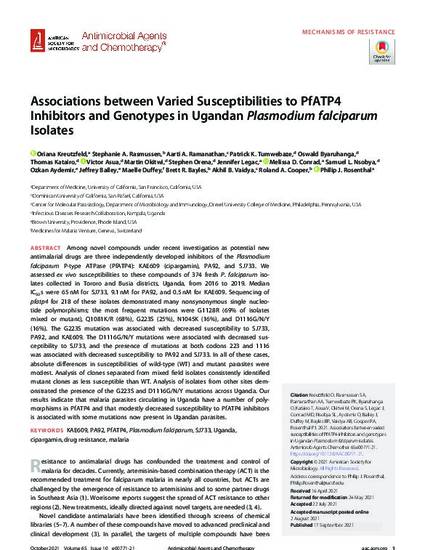
Among novel compounds under recent investigation as potential new antimalarial drugs are three independently developed inhibitors of the Plasmodium falciparum P-type ATPase (PfATP4): KAE609 (cipargamin), PA92, and SJ733. We assessed ex vivo susceptibilities to these compounds of 374 fresh P. falciparum isolates collected in Tororo and Busia districts, Uganda, from 2016 to 2019. Median IC50s were 65 nM for SJ733, 9.1 nM for PA92, and 0.5 nM for KAE609. Sequencing of pfatp4 for 218 of these isolates demonstrated many nonsynonymous single nucleotide polymorphisms; the most frequent mutations were G1128R (69% of isolates mixed or mutant), Q1081K/R (68%), G223S (25%), N1045K (16%), and D1116G/N/Y (16%). The G223S mutation was associated with decreased susceptibility to SJ733, PA92, and KAE609. The D1116G/N/Y mutations were associated with decreased susceptibility to SJ733, and the presence of mutations at both codons 223 and 1116 was associated with decreased susceptibility to PA92 and SJ733. In all of these cases, absolute differences in susceptibilities of wild-type (WT) and mutant parasites were modest. Analysis of clones separated from mixed field isolates consistently identified mutant clones as less susceptible than WT. Analysis of isolates from other sites demonstrated the presence of the G223S and D1116G/N/Y mutations across Uganda. Our results indicate that malaria parasites circulating in Uganda have a number of polymorphisms in PfATP4 and that modestly decreased susceptibility to PfATP4 inhibitors is associated with some mutations now present in Ugandan parasites.
Available at: http://works.bepress.com/roland_cooper/73/
